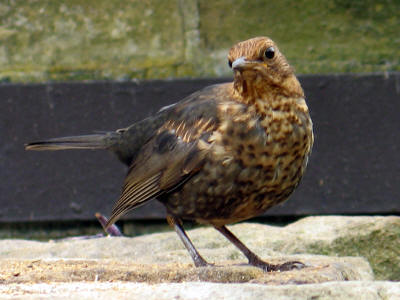Back To


Blackbirds pair in early spring the birds establish territories with dominant or experienced birds getting the best places in terms of food sources and nest sites. Other pairs may set up around the dominant pair but may not have access to good quality nest sites and may have to compromise. A little human help can make a large difference in this case by providing plenty of the right types of nest locations such that a higher proportion of successful nests will result and the population will increase.
Blackbirds usually build in a hedge (almost any type) where they like plenty of cover the height. They are opportunists and will use a shelf in a shed or any quiet space. The nest is made from a base of any old rubbish - grass, paper, plastic and anything else to form a platform. There can be an amazing amount of material used in this phase of the nest. Next comes an inner cup of mud mixed with grass or fibres to form a strong container. The female bird makes this by plastering new bits of material onto the existing structure and then settling down and puffing out her breast to make the right shape. Finally, the inside is lined with some finer grass and hair, perhaps a few feathers and that's it - done. The very first attempt each year can be quite a dismal affair and they seem to need a bit of practice to get it right.
Broods on average contain 4 eggs to get three fledgling out of the nest is a good achievement. Young are a light brown colour and speckled, gradually getting darker with age. Always check hedges before cutting them to avoid exposing a new nest to predators. Predators include Magpies , Cats and Squirrles
Like robins, blackbirds are easily "tamed" if fed regularly
Blackbirds tend to move out mid - late Summer to gorge on soft fruits if available in local hedgerows - Blackberries, Elderberries etc., only moving back into your feeding environment when this food source is exhausted - early Winter. So you may see many blackbirds including lots of new youngsters around daily but these may all vanish almost overnight and in good years (plenty of fruits), they may be gone for up to three months.












The males live up to their name but, confusingly, females are brown often with spots and streaks on their breasts. The bright orange-yellow beak and eye-ring make adult male blackbirds one of the most striking garden birds. One of the commonest UK birds, its mellow song is also a favourite.Where does it live?
Breeding
Blackbirds are birds of woodland and heaths which have readily adapted to farmland and gardens. They like areas with bushes, shrubs and trees, and nearby open ground and short grass.
Wintering
Blackbirds which come here for the winter like suitable cover for roosting - shrubs and trees - with feeding areas nearby. Often found along berry-bearing hedges and in open fields.
Where to see it
Found everywhere in gardens and countryside and from coasts to hills, although not on the highest peaks.
What does it eat?
Insects, worms and berries.
What does it sound like?
A mellow, fluty song. Calls include 'chink, chink' and a clattering, ringing alarm phrase.Click here to hear the Blackbird
When to see it
All year round.
Similar species
Ring ouzel